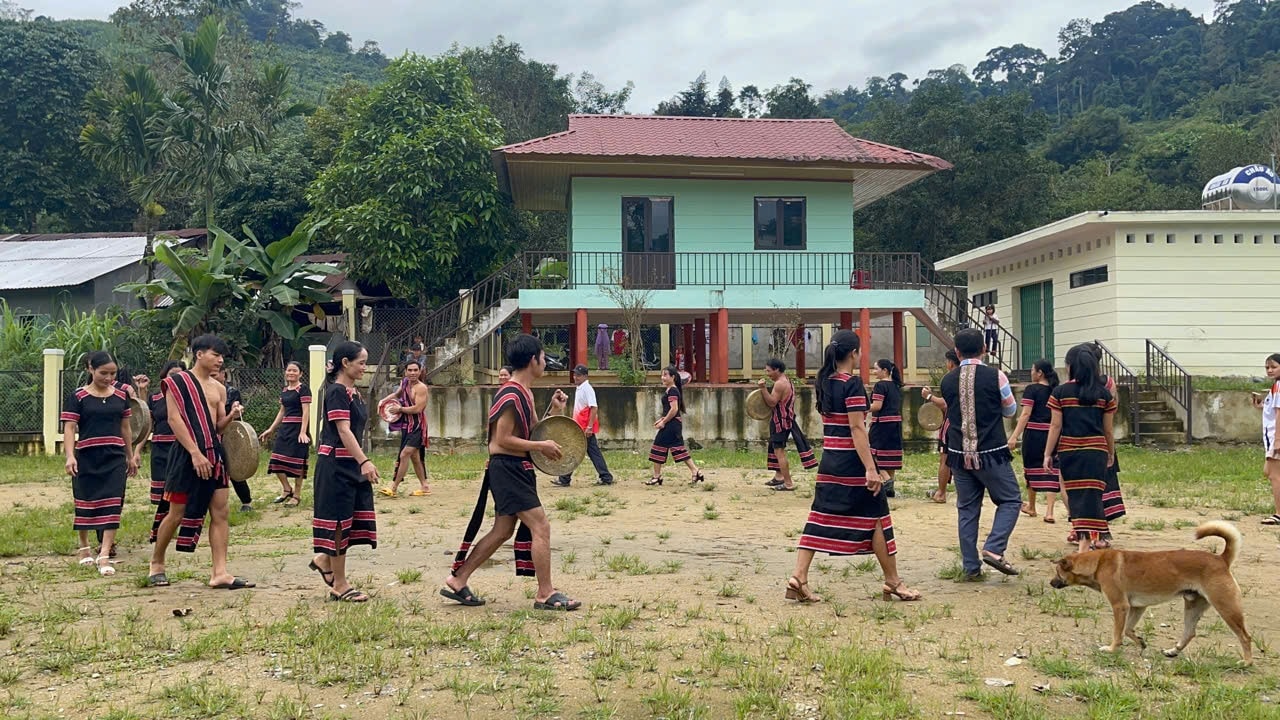
Nestled beside the Nuoc La stream, the village of Tak Chuom is like a miniature Tak Po, with houses clustered together and winding village paths. After the rain, a lingering mist envelops the stilt houses, as if preserving the memory of a village once known as the "wine cellar" of Tra Mai commune.
“Tăk Chươm used to be a nightmare for Trà Mai,” my colleague Hồ Văn Nái said. “In the memories of my generation, the village seemed to be ‘bewitched’ by alcohol. Almost every household had someone who drank, getting drunk from early morning until late afternoon.”
The village is located right in the center of the district, but day after day, the clinking sound of liquor in bamboo pipes replaces lullabies, and the sound of gongs and drums is absent during village festivals. Alcohol brings poverty, hunger, and tears. Many children grow up orphaned, losing both parents and grandparents, all because of a seemingly harmless glass of alcohol. The fields and rice paddies are overgrown with weeds.
The opportunity arose when Tra Mai was selected as a pilot commune for the new rural development program. And Tak Chuom – a part of the Tak Po center, which boasts favorable conditions in terms of transportation, electricity, schools, and health stations – could no longer remain a "wrinkle" in the landscape being painted.
Propaganda and mobilization campaigns were implemented vigorously. Cadres stayed in the villages, persistently "knocking on every door" and talking to each person. Alongside these efforts were practical projects: concrete roads within the villages were widened, and sturdy suspension bridges connected the two banks of the river. Houses were renovated, fences were rebuilt, and abandoned plots of land were gradually transformed into fields of cassava, corn, and rice paddies.
The change began with pioneering households – like Nái, the officials and civil servants who settled in the village – and then spread gradually. Seeing their exemplary behavior, the villagers began to give up drinking alcohol, put away their jars of fermented rice wine, and instead embraced hoes, plows, and dreams of a new day.
In 2023, Nam Tra My district officially included Tak Chuom in the list of community tourism villages. From here, a new chapter was written, recording a change in the mindset of the local people.

Tours offering experiences of Ca Dong life have been developed. Visitors stay in traditional stilt houses, enjoy mountain meals, participate in gong festivals, learn weaving, and listen to folk tales told in the Ca Dong language by the campfire at night.
Ms. Alang Thi Nhu Tien, in charge of the community art troupe in Tak Chuom village, said that each villager becomes a local "guide," each house becomes a rest stop, and each stream and patch of forest becomes a unique tourism product.
Once a week, the villagers gather to practice playing gongs and singing and dancing. Through frequent meetings and learning, their spirit of unity has grown stronger. Not only for themselves and their families, the people of Tăk Chươm village now know how to live for the community. They have collectively donated land to build a road leading to the waterfall behind the village, creating an additional attraction for tourists.
Every house now has a flower garden, every road is lined with flags and cultural signs. The name Tak Chuom is no longer associated with alcohol, but with festivals, with smiles and the vibrant colors of traditional brocade costumes amidst the vast forest.
Visiting Tăk Chươm today, the atmosphere is very different from the past. The sound of gongs and drums resounds every evening. In the hearths of each house, the sounds of stories about life and the village flicker. Children chatter excitedly on their way to school, while the elderly plant vegetables and raise chickens. Each person seems to be contributing a beat to the symphony of the village's revival.
Source: https://baoquangnam.vn/cuoc-chuyen-minh-cua-tak-chuom-3156863.html







![[Photo] Prime Minister Pham Minh Chinh presides over a meeting on private sector economic development.](/_next/image?url=https%3A%2F%2Fvphoto.vietnam.vn%2Fthumb%2F1200x675%2Fvietnam%2Fresource%2FIMAGE%2F2025%2F12%2F20%2F1766237501876_thiet-ke-chua-co-ten-40-png.webp&w=3840&q=75)





































































































Comment (0)